|

CLICK ON
PICTURE FOR LARGE IMAGE
CLOSE-UP
VIEWS OF BOTH SIDES OF THE PERFORATED PECCARY BONE SCAPULA
HENDRICKS
COLLECTION
These
pictures show both sides of what appears to be the point of impact from a
Paleo-Indian's bone spear point. The one on the left shows the smaller entrance
hole and the picture on the
right shows the larger exit hole.
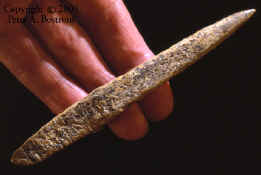
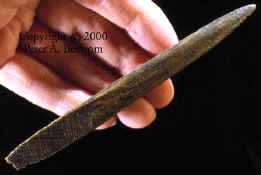
CLICK ON PICTURES FOR
LARGE
TRIPLE IMAGES
THESE TWO
BONE PROJECTILE POINTS WERE FOUND DURING THE EXCAVATION OF SHERIDEN CAVE
HENDRICKS
COLLECTION
These
two rare bone spear points were found inside Sheriden Cave. One was
discovered during the earlier paleontological project and the other during
the archaeological excavation. The one on the left is the most recent find in 2000.
The tip of the point on this one is in very good shape and is even
slightly polished. The example to the right was found in the earlier
excavation in the summer of 1995 by Kenneth Ford while excavating the
skeleton of a flat-faced peccary. This point has some very slight point
damage and is believed to be the one that perforated the peccary scapula
laying near by.

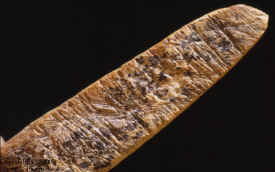
CLICK ON PICTURES FOR LARGE
IMAGES
CROSSHATCHING
ON BONE POINT BASES
HENDRICKS
COLLECTION
The majority of all Paleo-Indian bone and ivory spear points found in the
United States have been found in the east. Almost all of these are made of
ivory and were found in the
rivers of Florida
where preservation has been very good. But examples have also been
recovered from a few sites in the west. The similarities of the bone and
ivory artifacts and the fact that they are separated by thousands of miles
help archaeologist understand the movements of these early nomadic people.
Two of the projectile points from
Sheriden Cave are made of bone and are very rare. The bases of the points,
pictured here, are tapered where they were attached either directly or
indirectly with a foreshaft to a spear. They also have a crosshatching
design cut into the bases. This "roughening" probably helped
attach them more firmly in the haft with the use of tree resin (mastic) or other
adhesive substances.

"LADDER"
ENGRAVING ON BONE POINT
HENDRICKS
COLLECTION
This picture shows the 2 1/8 inch long "ladder" style engraving
cut on one side of this bone point from Sheriden Cave. Although thousands
of miles away, the Clovis bone rod pictured below has a similar design
also cut on one side.
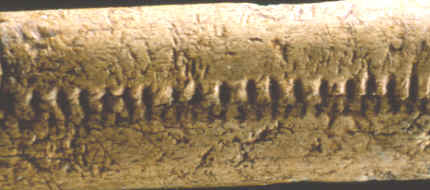
"LADDER"
ENGRAVING ON BONE ROD
EAST WENATCHEE
CLOVIS SITE
WASHINGTON
STATE HISTORICAL SOCIETY MUSEUM COLLECTION
This picture shows the engraved area on a double beveled bone rod found on
the East Wenatchee Clovis site in Washington. The "ladder" style
engraving on one side of this artifact is similar to the bone spear point
from Sheriden Cave shown above. Similarities like this, although their
function is not completely understood, help to make cultural connections
between widely separated sites.

BASE OF BONE POINT
FROM SHERIDEN CAVE
HENDRICKS
COLLECTION
The base of the more recently discovered bone point from Sheriden Cave was
fashioned with a small knob on the end. Since it's in the hafting area it
must have been used to help secure the point to the spear.
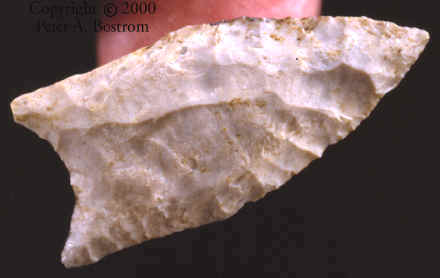
CLICK ON PICTURE FOR LARGE
TRIPLE IMAGE
FLUTED POINT
SHERIDEN CAVE
SITE
HENDRICKS
COLLECTION
A
CAST OF THIS FLUTED POINT IS AVAILABLE
This is the only complete stone spear point found during the excavation of Sheriden
Cave. Another fragment of a biface was found but a positive identification
as a projectile could not be made. This fluted point was found in 1998 by Paul J. Barans less than
three feet from where the first bone point was discovered in 1995. It has
been extensively resharpened and it doesn't seem likely that it would have
undergone any further resharpenings. It's possible that it may have even
been discarded by the original owner when he replaced it with a new point
on the end of his spear or foreshaft. Paleo-Indians were hunting with a wide range of
sizes of fluted points. Some of them seem too small for the animals they
were hunting. A fluted point measuring 1 1/4 inches long was found on the
mastodon kill site at Kimmswick. Even smaller fluted points have been
found on other Paleo-Indian kill sites. This example measures 1 3/8 inches
long but could have been at least 2 inches long when it was newly made.
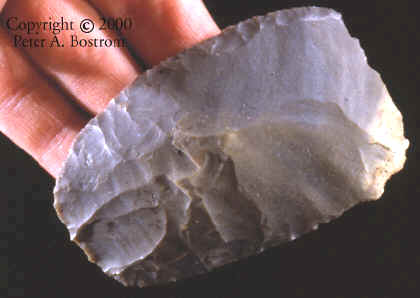
CLICK ON PICTURE FOR LARGE
TRIPLE
IMAGE
UNIFACE SIDE-SCRAPER
SHERIDEN CAVE
SITE
HENDRICKS
COLLECTION
This is the largest and best example of a stone tool that was found during
the excavation of Sheriden Cave. It
was discovered several years ago during the earlier excavation. This is a uniface
tool that would have been used for cutting and scraping. As for size, the
fake is much wider than most side-scrapers found on Clovis sites. Uniface side-scrapers have been
found on Clovis sites across the United States in
caches,
on
camp
sites,
stone
tool manufacturing sites
and kill sites. This example is made of
southern Indiana chert and measures 3 1/4 inches long and 2 3/16 inches
wide.
|